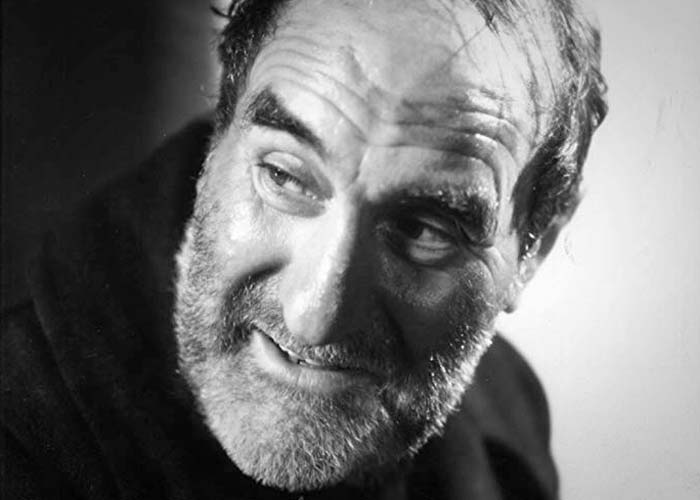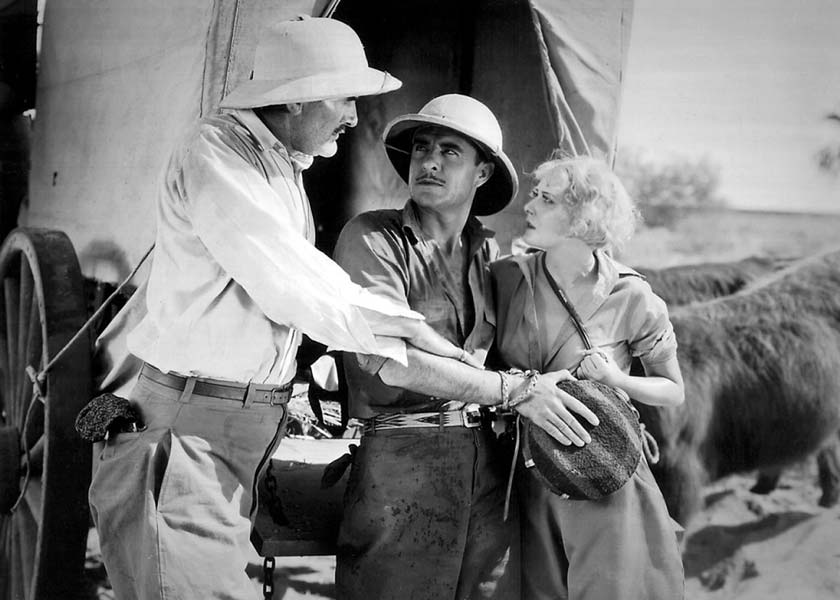Synopsis
Hugh Rand (Gilbert) is the manager of an African diamond mine. The security at the
mine is tight; numerous guards and a tall wire fence protect the premises. Lord
Stonehill (Torrence) and his daughter, Lady Diana Stonehill (Nolan), arrive with
their secretaries and chauffer to visit the mine. Hugh, attracted to the beautiful
Diana, does not realize the Stonehills
are, in fact, thieves, posing as
father and daughter, planning to rob the mine.
Deceiving the workers at the mine, the thieves seize a large number of uncut diamonds. On pretense of a hunting expedition, Lord Stonehill, Diana, their assistants, a group of African porters, and the kidnapped Hugh drive into the Kalahari desert. In the hot and waterless desert, the thieves part ways. The three assistants take their share of the diamonds (actually worthless glass that Lord Stonehill has given them) and head for Cape Town. Hugh, tied up in the wagon, watches them go. By the next morning, the African porters have fled; Stonehill, Diana, and Hugh are alone. One of the assistants returns, dying. The water hole was poisoned. Stonehill says he poisoned it to prevent his confederates from betraying him.
Some time later, the remaining trio find themselves low on water, and Hugh takes charge. They stagger through the desert until they arrive at a palm oasis. Lord Stonehill takes the diamonds and runs off. A sudden sandstorm envelops them all.
Several days later, Lord Stonehill stumbles out of an oasis into a large wire
fence. He is back at the mine complex. Brought into the office, he finds Hugh,
shaved, and again in charge. Hugh had led them in a circular movement back to the
mine. Stonehill is arrested for robbery and murder. Hugh forgives Diana and
proposes a life sentence.
Discussion
Desert Nights, although slow-moving and short on action, is dominated by the forceful acting of John Gilbert — in his last silent role — and Ernest Torrence. Torrence, a master of silent acting technique, artfully expresses thought and feeling without spoken words. Gilbert was also a fine actor, though with a smaller range than Torrence. Mary Nolan ably expresses her descent into desperation as the group struggles through the Kalahari desert of Southern Africa. (The Palm Springs area east of Los Angeles, California, stands in for the Kalahari.)
Desert Nights is typical of many films made at the transition from silents to talkies. Although a mostly silent film, it does have a musical score and sound effects recorded using the Movietone sound system which recorded sound directly onto the film strip (as opposed to the sound-on-disc Vitaphone system used in films such as The Donovan Affair). MGM was slower than the other major studios to make the transition to sound following the huge success of The Jazz Singer (1927). In 1929, of the 47 films the studio made, thirteen are silents and six are part-talkies. MGM was also slow to put its major stars into talkies; Greta Garbo and Lon Chaney each appeared in two silent films in 1929 and neither made a talkie until 1930. The studio may have been concerned about ensuring their stars made their talkie debuts in appropriate vehicles.
Desert Nights was a minor release for Gilbert. Popular with the public, the film provided box office presence for Gilbert while the studio prepared the story and script of his first talkie, His Glorious Night, released in September, 1929. Unfortunately for Gilbert, both His Glorious Night and his second talkin picture, Redemption, were critical and box office failures. An attempt to toughen up his image as an unpolished sailor in Way for a Sailor (1930) likewise met with little interest. His downfall was rapid for such a major star.

Ernest Torrence was tall, broad, solidly built, and decidedly unhandsome, but possessing tremendous screen presence. He could make an audience love him or hate him with equal ease. Born in Edinburgh, Scotland, talking pictures revealed his deep voice and Scottish accent. Torrence started his career as a concert pianist in Edinburgh and by 1900 had gone into musical comedy as a baritone. Director Henry King saw him on Broadway and wanted him for the homicidal villain in his upcoming film Tol’able David (1921), where Torrence’s size and rugged, homely features would contrast his villain (one of the most ferocious in movie history) strongly with Richard Barthelmess' smaller, delicate-looking hero. Tol’able David, one of the finest of all silent films, was a hit, and Torrence never went back to the stage. In addition to villainy, Torrence could also assume a mild, friendly mien expressive of melancoly or sentimentality. His character in Desert Nights is a seemingly lighthearted villain concealing a murderous nature.
Torrence was a busy supporting actor; his memorable roles include a pioneer scout in The Covered Wagon (1923), Captain Hook in Peter Pan (1924), the backwoods husband of Clara Bow in Mantrap (1926), and the Apostle Peter in King of Kings (1927). As the exasperated father in Steamboat Bill, Jr. (1928), his large size and rugged appearance are comically contrasted to the looks of the small, lightweight, mild-featured Buster Keaton. Torrence continued successfully into the talkies and in three years had appeared in over a dozen films, including a musical comedy, Sweet Kitty Bellairs (1930), in which he sang for the first time on screen. His final film, I Cover the Waterfront (1933), had not been released when he died after an operation for gall-stones.
Lenore J. Coffee, credited for continuity in Desert Nights, had a 35-year film career that began at MGM in the 1920s and continued to the end of the studio system in the late 1950s. During the silent era, she wrote original stories and scenarios. During the 1930s, when she was the only woman writer working at Warner Bros., Coffee wrote many scenarios and screenplays. Her script (cowritten with Julius J. Epstein) for Michael Curtiz's Four Daughters (1938) was nominated for an Academy Award for Best Writing (Screenplay). Her specialty, however, was as a script doctor, correcting and reformulating the work of other writers, and she regarded herself as a fixer-upper.
Director William Nigh’s forty-year career began at the start of the feature film era as a co-director of Salomy Jane in 1914, made by The Motion Picture Corporation, a small studio in Northern California. By 1927, Nigh had directed over thirty feature films, mostly for small, short-lived studios and with lower-tier stars. Nigh spent 1927-29 at prestigious MGM, working with the best casts, crews, and facilities of his career. He directed films starring Lon Chaney, John Gilbert, Ramon Navarro, and Tim McCoy. Although relatively minor releases for their stars, these films are well-made, with good supporting casts, first rate camerawork, and fine production values. After leaving MGM, Nigh spent the remainder of his career making B films for low-budget studios, including many films at Monogram Studios, notably several of Boris Karloff’s Mr. Wong series, Karloff in The Ape (1940), and Bela Lugosi in Black Dragons.
Further Reading

